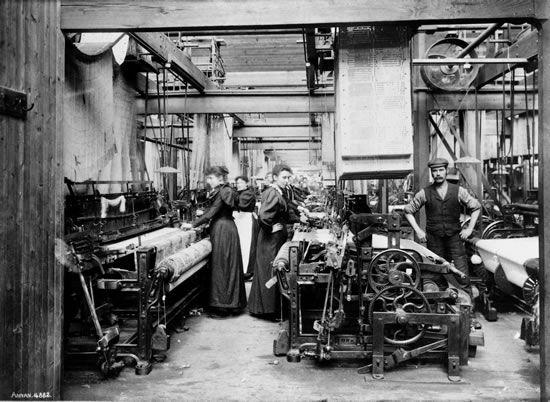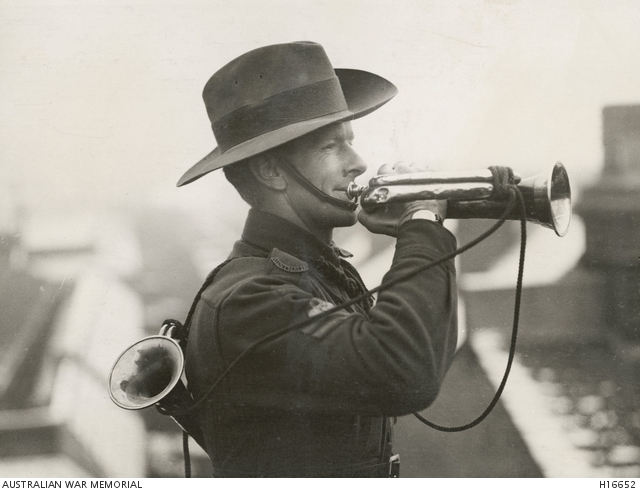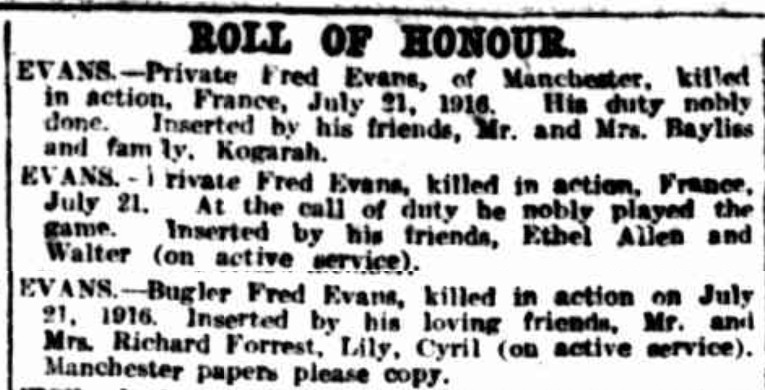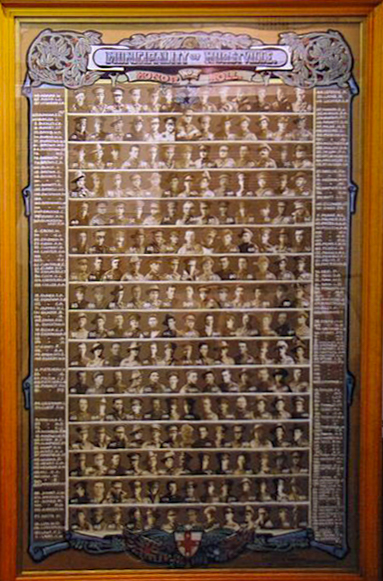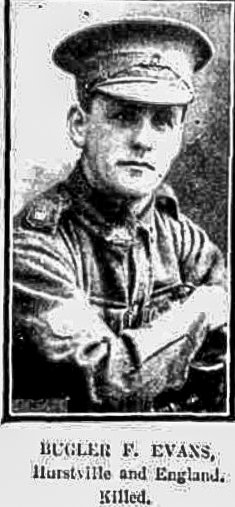
Frederick EVANS
Eyes grey, Hair brown, Complexion dark
Fred Evans – A Salford UK Fitter in the 53rd
Can you help find Fred?
Fred Evans’s body was never found after the Battle of Fromelles and there are no records of his burial.
A mass grave was found in 2008 at Fromelles, a grave the Germans dug for 250 Australian soldiers they recovered after the battle. As of 2024, 180 of these soldiers have been able to be identified via DNA testing.
Fred may be among these remaining unidentified men. There is still a chance to identify him — but we need help. We welcome all branches of his family to come forward to donate DNA to help with his identification, especially those with roots in Salford, England.
See the DNA box at the end of the story for what we do know about his family.
If you know anything of contacts for Fred, please contact the Fromelles Association.
Early Life
Fred Evans was born on 29 September 1887 at 16 Prospect Street, Salford, Manchester, England, the son of John James Baker Protheroe Evans and Ellen (Helen) Sherratt. John and Helen had eight children:
- John Richard (1880–1955) – married Holly Christine King in 1906; lived in Victoria, later returned to England
- Mary Alice (1881–1943) – lived in Liverpool
- Samuel (1882–1947) – married Annie Beatrice Hicks; lived in Salford
- Fred (1887–1916) – emigrated to Australia ~1911; killed in action at Fromelles
- Florence Ellen (1889–1973) – lived in Lancashire
- Rachel Ann (1891–1980) – married Ernest Albert Horbury; lived in Nottinghamshire
- Margaret Elizabeth (1893– ) – married Chris Charles Lewis; lived in Salford
- Annie (1895–1994) – married George Henry Hunter; lived in Hampshire
Fred grew up in Salford and attended a Church of England school. Fred’s father was a calico printer and many of the family followed working in the cotton industry. Sam and Fred worked with cotton machinery and Fred also became a merceriser, apllying chemicals to make the cotton stronger. Florence, Rachel and Margaret worked in the cloth warehouse and Annie was an apprentice mantle maker.
Son John was a ship’s cook and he settled in Australia in 1906, where he married Holly King. They had two children who sadly died in infancy 1906 and 1907. They returned to Lancashire, where their daughter Ivy was born in 1911. Holly, was a Variety Artiste. According to his enlistment papers, Fred had served for two years in the Royal Navy and was discharged in 1911, after which he returned to the calico business. Fred then decided to follow in his brother’s wake and emigrated to Australia at some time between 1911 and 1915.
He made his new home in Hurstville, New South Wales and was working as a fitter. He developed strong community connections in his adopted country, becoming a member of the Lancashire Society of New South Wales and the United Ancient Order of Druids.
Off to War
Fred heard the call to war and enlisted in the AIF at Warwick Farm, New South Wales, on 13 September 1915. He was allocated to the 1st Battalion, 15th Reinforcements. (He did ‘shave’ a few years off of his age on his enlistment papers, not an uncommon practice.) After his initial military training, he embarked from Sydney aboard HMAT Star of England on 8 March 1916. On his arrival in Egypt, he went to the training camp at Tel-el-Kebir, which was about 110 km northeast of Cairo.
The 40,000 men in the camp were comprised of Gallipoli veterans and the thousands of reinforcements arriving regularly from Australia. With the ‘doubling of the AIF’ as it expanded from two infantry divisions to five, major reorganisations were underway. The 53rd Battalion had been formed on 16 February 1916 and was made up of Gallipoli veterans from the 1st Battalion and the new recruits from Australia. Fred was transferred to the 53rd on 20 April 1916.
Presumably from his Royal Navy days, Fred was a Bugler:
Buglers were more than musicians: they acted as both combat soldiers and essential communication specialists, sounding daily calls such as reveille and cease fire, and in battle, conveying vital commands — to advance, halt, or retreat — through specific bugle calls. This made them highly visible targets for enemy snipers. Beyond signalling duties, buglers also played in battalion bands for entertainment and provided solemn ceremonial duties, including the Last Post at funerals and commemorations.
After his joining the 53rd, Fred spent most of his time at Ferry Post, guarding the Suez Canal from any potential threats posed by the Ottoman Army. On 16 June they began the move to the Western Front. 32 officers and 958 soldiers of the 53rd left Alexandria on 19 June on the troopship HMT Royal George, bound for Marseilles, France to become part of the British Expeditionary Force on the Western Front. They arrived in Marseilles on 28 June and were immediately entrained for a 62-hour journey north to Hazebrouck before finally marching into the camp at nearby Thiennes in northern France. During their trip it was noted that their ‘reputation had evidently preceded them’, as they were well received by the French at the towns all along the route.
Source - AWM4 23/70/2 53rd Battalion War Diaries February - June 1916, p. 4
This area near Fleurbaix was known as the “Nursery Sector” – a supposedly relatively quiet area where inexperienced Allied troops could learn the harsh realities of Western Front trench warfare against the Germans. But the quiet times and the training period did not last long as they moved closer to Fleurbaix.
The Battle of Fromelles
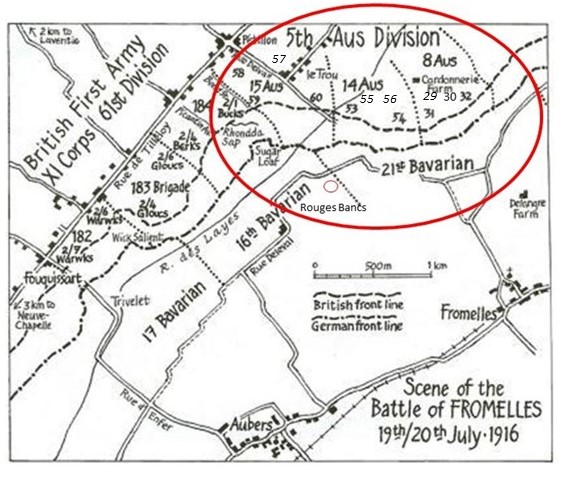
On 10 July, the 53rd entered trenches for the first time. The front near Fleurbaix was anything but calm. Rain flooded the communication trenches, artillery fire harassed supply lines and the soldiers dug in amid the mud and barbed wire of No-Man’s-Land. They rotated between billets and the line, rehearsing attacks, inspecting bayonets, and watching the big guns roll up behind their positions. The men knew something was coming.
On 16 July, they moved up for an attack on the 17th—only to have it postponed due to weather. The delay proved torturous. Private Jim Granger (4784), a young Dorrigo soldier, described the tension in his dugout:
“We were held in suspense for three days… like a criminal waiting to hear the verdict. We had no dugouts where we were in the supports and shrapnel was bursting all round.”
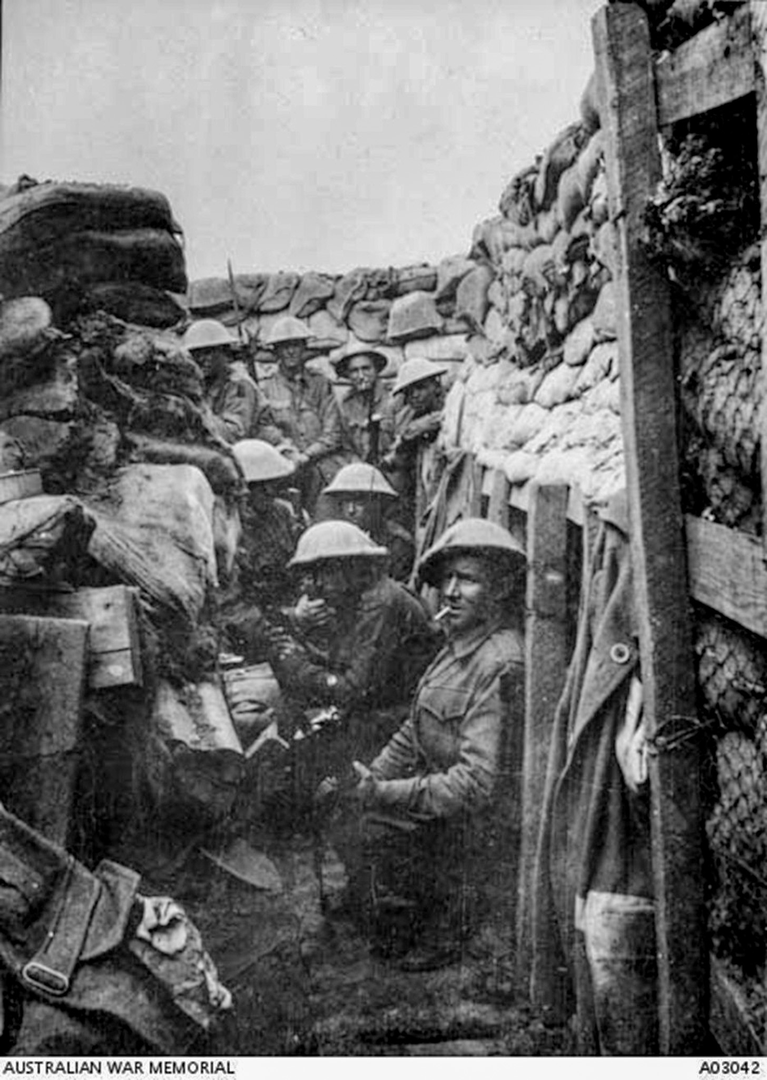
On the 19th, heavy bombardment was underway from both armies by 11.00 AM. At 4.00 PM the 54th Battalion were into the trenches on their left. All were now in position for battle. Zero Hour for advancing from their front-line trenches was to be 5.45 PM, but the Germans knew this attack was coming and were well-prepared. They opened a massive artillery bombardment on the Australians at 5.15 PM, causing chaos and many casualties. The main objective for the 53rd was to take the trenches to the left of a heavily armed, elevated German defensive position, the ‘Sugar Loaf’, which dominated the front lines. If the Sugar Loaf could not be taken, the 53rd and the other battalions would be subjected to murderous enfiladed fire from the machine guns and counterattacks from that direction.
As they advanced, they were to link up with the 60th and 54th Battalions on their flanks. The Australians went on the offensive at 5.43 PM. They moved forward in four waves – half of A & B Companies in each of the first two waves and half of C & D in the third and fourth. They did not immediately charge the German lines, they went out into No-Man’s-Land and lay down, waiting for the British bombardment to lift. Private Arthur Crewes (4755) wrote of the time:
“At 5.43 pm the signal for the charge sounded, and over the top we went into the face of death, shells bursting, machine guns rattling and rifles crackling.”
At 6.00 PM the German lines were rushed. The 53rd were under heavy artillery, machine gun and rifle fire, but were able to advance rapidly. Corporal J.T. James of C Company (3550) reported:
“At Fleurbaix on the 19th July we were attacking at 6 p.m. We took three lines of German trenches”
As below, the 14th Brigade War Diary notes that the artillery had been successful and “very few living Germans were found in the first and second line trenches”, but within the first 20 minutes the 53rd lost ALL the company commanders, ALL their seconds in command and six junior officers.
Source - AWM C E W Bean, The AIF in France, Vol 3, Chapter XII, pg 369
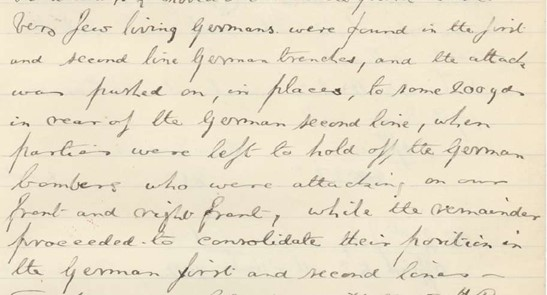
Some of the advanced trenches were just water filled ditches, which needed to be fortified by the 53rd to be able to hold their advanced position against future attacks. They were able to link up with the 54th on their left and, with the 31st and 32nd, occupied a line from Rouges Bancs to near Delangre Farm, but the 60th on their right had been unable to advance due to the devastation from the machine gun emplacement at the Sugar Loaf.
They held their lines through the night against “violent” attacks from the Germans from the front, but their exposed right flank had allowed the Germans access to the first line trench BEHIND the 53rd, requiring the Australians to later have to fight their way back to their own lines. By 9.00 AM on the 20th, the 53rd received orders to retreat from positions won and by 9.30 AM they had “retired with very heavy loss”.
Source - AWM4 23/70/2 53rd Battalion War Diaries July 1916 page 7
Of the 990 men who had left Alexandria just weeks before, the initial count at roll call was 36 killed, 353 wounded and 236 missing:
“Many heroic actions were performed.”
To get some perspective of the battle, when Charles Bean, Australia’s official war historian, attended the battlefield two and half years later, he observed a large quantity of bones, torn uniforms and Australian kit still on the battlefield. The final impact of the battle on the 53rd was 245 soldiers were killed or died from their wounds and, of this, 190 were not able to be identified, including Fred.
After the Battle
Fred was initially reported as one of those missing, but a formal review on 6 September 1916 declared him as having been killed in action on 19 July 1916.
There are no Army or Red Cross witness statements about what happened to him. His parents in Manchester received the official cable that he had been killed in action. News home was slow and Fred’s his friends in Sydney sought confirmation of his fate. When it was confirmed, they submitted tributes in the local papers - a lot of respect for someone who had only been in Australia for a few years.
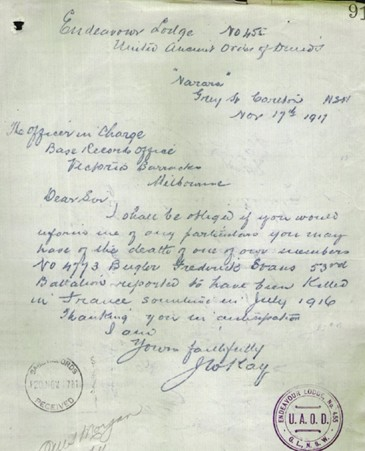
Fred was awarded the British War Medal, the Victory Medal, a Memorial Scroll and a Memorial Plaque. He is commemorated at:
- VC Corner Australian Cemetery and Memorial in Fromelles, where the inscription “Known Unto God” honours those with no identified resting place.
- Hurstville War Memorial
- Municipality of Hurstville Pictorial Honour Roll No. 2.
Finding Fred
Fred’s remains were not recovered, he has no known grave. After the battle, the Germans recovered 250 Australian soldiers and placed them in a burial pit at Pheasant Wood. This grave was discovered in 2008 and since then efforts have been underway to identify these soldiers by DNA testing from family members. As of 2024, 180 of the soldiers have been identified, including 15 of the 190 unidentified soldiers from the 53rd Battalion. We welcome all branches of Fred’s family to come forward to donate DNA to help with his identification, especially from the Evans and Sherratt lines.
If you are related or know someone who might be connected to his family — particularly those with roots in Salford, Lancashire, please contact the Fromelles Association. We hope that one day Fred will be named and honoured with a known grave.
Please visit Fromelles.info to follow the ongoing identification project and Fred’s story.
DNA samples are being sought for family connections to
| Soldier | Fred Evans (1887–1916) |
| Parents | John James Baker Protheroe Evans (1849–1932), Bath, Somerset, England – d. Salford, Lancashire, England and Helen (Ellen) Sherratt (1859–1923), Salford, Lancashire, England – d. Salford, Lancashire, England |
| Siblings | John Richard Evans (1880–1955) – married Holly Christine King | ||
| Mary Alice Evans (1881–1943) | |||
| Samuel Evans (1882–1947) – married Annie Beatrice Hicks | |||
| Florence Ellen Evans (1889–1973) | |||
| Rachel Ann Evans (1891–1980) – married Ernest Albert Horbury | |||
| Margaret Elizabeth Evans (1893– ) – married Chris Charles Lewis | |||
| Annie Evans (1895–1994) – married George Henry Hunter |
| Grandparents | |||
| Paternal | Evans Evans Dr (1814–1880), Bidford, Warwickshire – d. Somerset and Mary Baker (1815–1880), York – d. Somerset | ||
| Maternal | Samuel Sherratt (1829–1893), Blackrod, Lancashire – d. Salford; Margaret Winstanley (1829–1889), Lomnargreen, Lancashire – d. Salford |
Seeking DNA Donors

Contacts
(Contact: carla@fromelles.info or geoffrey@fromelles.info).
(Contact: army.uwc@defence.gov.au or phone 1800 019 090).
Donations
If you are able, please contribute to the upkeep of this resource.
(Contact: bill@fromelles.info ).
